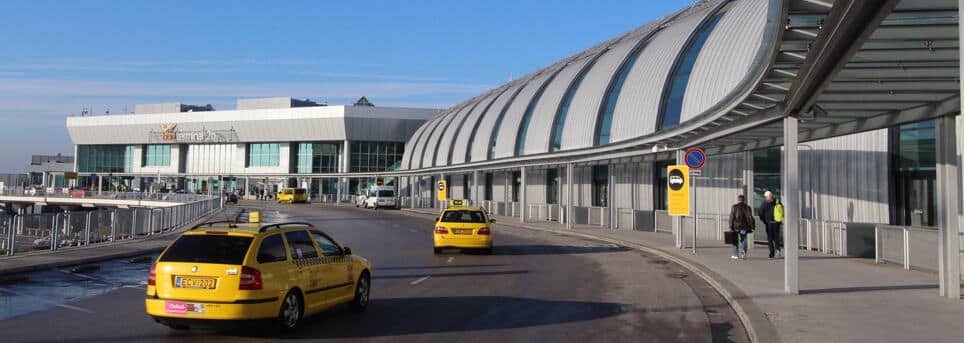The Challenge
Budapest Airport, the largest airport in Hungary serving 14.8 million passengers in 2018, asked AiQ Consulting to undertake a capacity assessment for their current departures and arrival baggage process. This project, led by AiQ Senior Airport Nomaan Asghar took place in three phases, with baggage in the first phase, ORAT (Operational Readiness Activation and Transition) in the second and the third, taking place currently, in operations.
There were several long standing capacity issues within the baggage hall that the client wished to improve on, including insight into capacity, management process and operations procedures. The airport was also going through growth so had undertaken a schedule uplift in comparison to summer the previous year.
Our challenge was to get the airport through the summer while a new temporary baggage facility was constructed. Our team had to define the capacity of the baggage halls, develop a set of planning and operating procedures and principles, establish handler allocations and assist the team to introduce a better management system and put that in place.
The Solution
We defined the capacity for Budapest Airport by carrying out onsite architectural surveys. This involved the demarcation of baggage make up positions (MUPs) within the baggage hall to give a total and final capacity. We then established Standard Operating Procedures (SOP) for the baggage sortation hall to support the Baggage Make-up (MUP) and Carousels Allocation Planning whilst defining Best Practices to enable ground handlers to work in collaboration. We then introduced a new management system with creating a new job role, Baggage Hall Supervisors, a new team that looks after day-to-day baggage operations. This included writing job descriptions for their new management team and Standard Operating Procedures for the baggage hall.
The airline community requested longer and earlier check in opportunities, so we introduced an Early Bag Store (EBS) for the airport. We undertook a sizing up exercise, as well as writing the operating procedure and principles for EBS. This is now in place and operational.
We also carried out an Arrivals survey, looking at arrivals capacity, the immigration process, arrivals belts and the processes of each. This was at a high level to understand the capacity, the breaking points and the opportunities around arrivals.
The Benefits
We defined the capacity and highlighted where the operational bottlenecks occur and at what time. Working with the client we identified the root causes for these bottlenecks and gave recommendations on how to overcome these resource constraints. Our team outlined new operating rules and principles along with introducing a new management systems and job roles to help with day-to-day smooth efficiency of the operations.
Through our outputs, specifically CAD drawings using our in-house architect, we provided scheme level drawings allowing them to define their space constraints and drew up plans for improvements in the physical layout. . Our MUP plans and clear airport capacity scenario models clearly communicated the results and enabled smart decision making for our clients. We also used other analytic tools and our own bespoke demand, capacity and simulation modelling tool, TransvisionAiRTM, to allow them to envisage the changes we were proposing to the baggage line, carousals lines, check in desks that would resolve the bottlenecks.
Our clients were the Head of Airport Operations at Budapest Airport, Head of Baggage at Budapest Airport and the COO of Budapest Airport Ltd and we also worked with high profile airlines such as Emirates and the Lufthansa Group. Our outputs were designed to allow them to understand what their problems were, at a big picture level, as well as the essential fine details such as the time of problems, peaks, schedule considerations, airlines, and handlers.
This successful project led onto assisting the client with the second phrase to implementing our above recommendations. Read this ORAT case study here
- Highlighted the operational bottlenecks - where and what time
- Identified operational bottlenecks root causes
- Recommendations for operational efficiency and resource allocation
- Improved operational practices with new operating rules and principles
- Introduced new management systems and job roles
- Increased capacity and flexibility
- Holistic view delivering real value to overall airport operations
- Architectural surveys and drawings created in house by AiQ providing efficiency and accuracy benefits
- Capacity assessment on various scenarios
- Improved passenger customer service and airport experience
- Recommendation of new technologies
What the client says
“As well as getting the essential input from important stakeholders, AiQ Consulting were able to work alongside us introducing our new management system that has substantially improved the day-to-day efficiency of our operations.” Head of Airport Operations, Budapest Airport
“Without the insight and professionalism of the AiQ Consulting team led by Nomaan Ashgar and the capacity models provided, we would have been unable to identify the root causes of issues and how they could be overcome. Clearly defined procedures with SOPs and Process Maps of each process have led to a much more efficient and effective baggage system.” Head of Baggage, Budapest Airport
“AiQ has allowed us to see the bigger picture for Budapest Airport, helping to solve challenges as we grow. We’re now able to plan for the future with confidence, knowing that our departures baggage system, management systems and operations procedures are operating to the best of their abilities.” Huszka Péter – Chief Operating Officer, Budapest Airport


